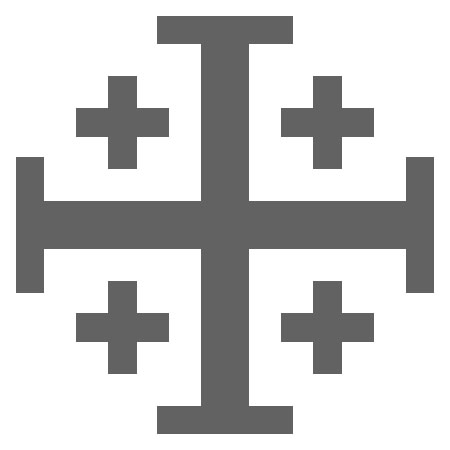The Jerusalem Cross is a major symbol used in Christianity, representing Christ’s command to spread the Gospel around the world beginning in Jerusalem. The symbol is basically composed of 5 crosses; 1 large central cross with 4 smaller crosses in each quadrant. It is also often referred to as the Crusader’s Cross and less frequently as the Cantonese Cross.
The Crusaders used the Jerusalem Cross as an emblem; bearing the symbol on the papal banner given to them by Pope Urban II. It was adopted by Godfrey de Bouillon as his personal coat of arms. He was one of the leaders of the Crusades and became the first ruler of Jerusalem (he refused the title of “king”) after successfully driving out the Moslems during the First Crusade in 1099.
Popular interpretations of the Jerusalem Cross:
- The central cross stands for Christ and the four smaller crosses stand for the 4 evangelists John, Luke, Mark, and Matthew.
- The large cross represents Christ as the strength at the center of Christianity and the smaller crosses as the 4 corners of the earth to which the faith spread.
- The crosses represent the wounds that Christ suffered when He was crucified; the central cross for the wound on His side, and the 4 smaller crosses for the wounds on His hands and feet.
- The 5 crosses represent the five nations that figured in The Crusades: Great Britain, France, Spain, Germany, and Italy.

» Amulet
» Ajna
» Arsenic
» Merkaba
» Hung
» Yin Yang
» bindi
» IK Onkar
» Khanda
» Halo
» jiahu
» Tau
» Uraeus
» Menorah
» Quincunx
» Tilaka
» Taijitu
» Vajra
» Chai
» Chi Rho
» Bagua
» Dragon
» Hunab Ku
» Caduceus
» Infinity
» Ichthus
» Hedjet
» Lauburu
» Om
» Ankh
» Chalice
» Pentacle
» Maat
» Ogham
» Mandala
» Kartika
» Khamsa
» Heart
» Labrys
» Sun Face
» Raven
» Triskele
» Scarab
» Dove
» Hanukia
» Anubis
» Trishula
» Durga
» Mezuzah
» Bay Tree
» Geruda
» Kinnara
» Quito
» Condor
» Blue Jay
» Falcon
» Makara
» Rosary
» Uluru
» Apsaras
» Hanuman
» Serpent
» Minotaur
» Mercury
» Apex
» Vestra
» Yoni
» Astarte
» dakini
» Calabash
» Mandrake
» Rebis
» Typhon
» Vegvísir
